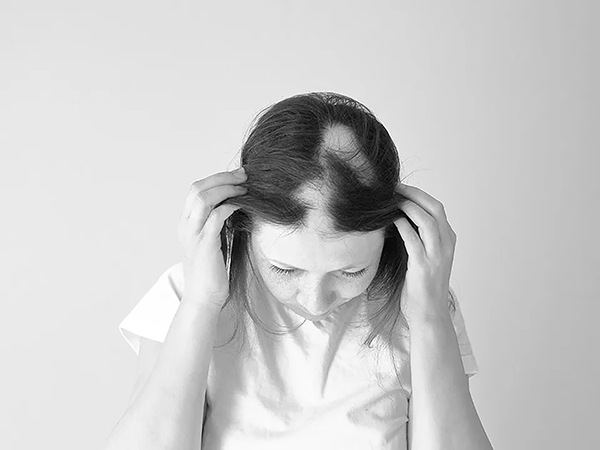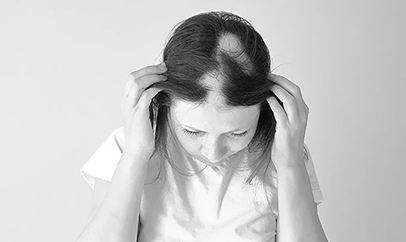
Hair loss, commonly known as alopecia, is a condition that inhibits hair growth by disrupting the body’s natural hair growth cycle. Hair loss is not limited to the scalp, but it can affect any part of your body. The disorder is either temporary or permanent.
Hair loss affects about 50 million men and 30 million women in the United States. By the age of 50, over half of all men and 45 percent of women will have had some form of hair loss.
Alopecia could be due to family history, hormonal changes, medical issues, or age. It’s essential to see a dermatologist to evaluate the problem and identify a proper hair loss treatment. At Pure Dermatology Cosmetic & Hair Center, get the best advice on possible hair restoration treatments that work for you.
What Are The Symptoms Of Hair Loss?
- Gradual hair thinning. This is the most frequent hair loss symptom, which occurs as people become older. Hair begins to recede near the hairline, on the forehead in men. In most cases, women’s hair starts parting around the crown, and the scalp slowly becomes visible.
- Patchy or circular bald spots on the scalp. Some people lose hair in circular or spotty bald areas.
- Sudden loosening of hair. You may notice handfuls of hair falling out when washing, combing, or gently tugging your hair. This may be a result of hair thinning.
- Scaly patches spreading on your scalp. The appearance of a scaly and patchy scalp may be a sign of a scalp infection. The patches are sometimes accompanied by redness, swelling, and thinning hair.
Loss
On average, people lose 50 to 100 hairs per day. Because new hair grows at the same time, this is usually undetectable. Hair loss occurs when the new hair does not replace the ones that fall out. Persistent hair loss could be a sign of an underlying health problem that requires treatment.
- Genetics and family history – Some type of hair loss is a result of genetics, passed down through the generations. These genes can affect both men and women, predisposing an individual to patterned baldness.
- Hormonal Changes – Hormonal changes in the body influence some types of hair loss problems. For example, abnormal hormone levels caused by thyroid issues, menopause, pregnancy, or childbirth can disrupt the normal hair growth cycle.
- Autoimmune disorders – Alopecia Areata is a hair loss condition that can affect persons with autoimmune illnesses. The disorder damages the hair follicles, resulting in hair loss and thinning. However, the hair will eventually regrow if you receive treatment for the autoimmune disease.
- Injuries – Temporary hair loss can occur due to skin trauma such as injuries or burns before the hair follicles begin to regenerate. Scar tissue on the injured area hinders hair follicle regeneration, resulting in permanent hair loss.
- Poor nutritional habits – To grow, your hair needs enough nutrition. Hair loss can onset due to eating a diet lacking in vitamins, proteins, and iron.
- Cosmetic hair procedures and treatment – The use of heated combs, blow dryers, and hair straighteners may degrade your hair’s health over time, resulting in hair loss. Hair loss can be caused by pulling and tugging during hair styling. Hair thinning can also occur due to bleaching, perms, and dyeing. Severe scalp trauma can cause inflammation and scarring, which can lead to permanent hair loss.
- Radiation therapy and drug treatments – Hair loss is a possible side effect of radiation therapy and the use of certain medications. Although the effect is just temporary, your hair may not regrow in the same manner. Chemotherapy drugs, such as beta-adrenergic blockers, birth control pills, and blood thinners, are frequently linked to hair loss.
- Stress and illness – After physical or mental stress, many people notice a general thinning of their hair. Anxiety caused by stressful events or situations may lead to hair loss. In addition, scalp infections such as ringworms can result in hair loss. Managing your stress levels and treating the disease, on the other hand, can help you grow your hair and prevent further hair loss.
Hair Loss Prevention
There are a few things you can do to prevent that hair loss and retain your hairline. First, you need to be gentle with your hair. When brushing and combing your hair, use a detangler and avoid tugging, especially if your hair is wet. You can reduce hair damage by lowering the amount of pressure used on your hair.
Secondly, good eating habits are beneficial to both your health and your hair. A well-balanced diet provides your hair with the vitamins and proteins it needs to grow and cure damaged hair follicles.
Additionally, avoid using hair wash and styling tools that may cause hair breakage or loss regularly. Also, stay away from hair bleach and dyes. Protect your hair from ultraviolet rays from the sun and other sources. Wear hats or hair conditioners that offer UV protection.
Treatment for Hair Loss
First of all, before undergoing any treatment, it’s important to determine the cause of your hair loss. If an underlying medical condition causes it, the condition needs special treatment.
There are two sorts of hair loss treatments that you can choose from:
Medications for Hair Loss
Dermatologists frequently treat hair loss with prescription drugs such as minoxidil and finasteride. The effects of the drug are usually visible 6 to 12 months after you start treatment. These drugs, however, can have substantial side effects. Therefore, always consult with your dermatologist before using them.
Surgery for Hair loss
Surgeons can correct permanent hair loss with surgery. Hair restoration surgery is a medical technique that includes transplanting hair to a balding area. There are two common types of hair replacement surgery:
- Follicular unit transplant (FUT)– A strip of skin from the back of your scalp and implants in the bald parts of your scalp using micro-incisions.
- Follicular unit extraction (FUE)– The dermatologist extracts hair follicles from the back of your head and implants them into hundreds of tiny needle incisions in the area that requires treatment.
Do you have any questions about hair loss and its treatment therapies? Don’t hesitate to get in touch with us.


